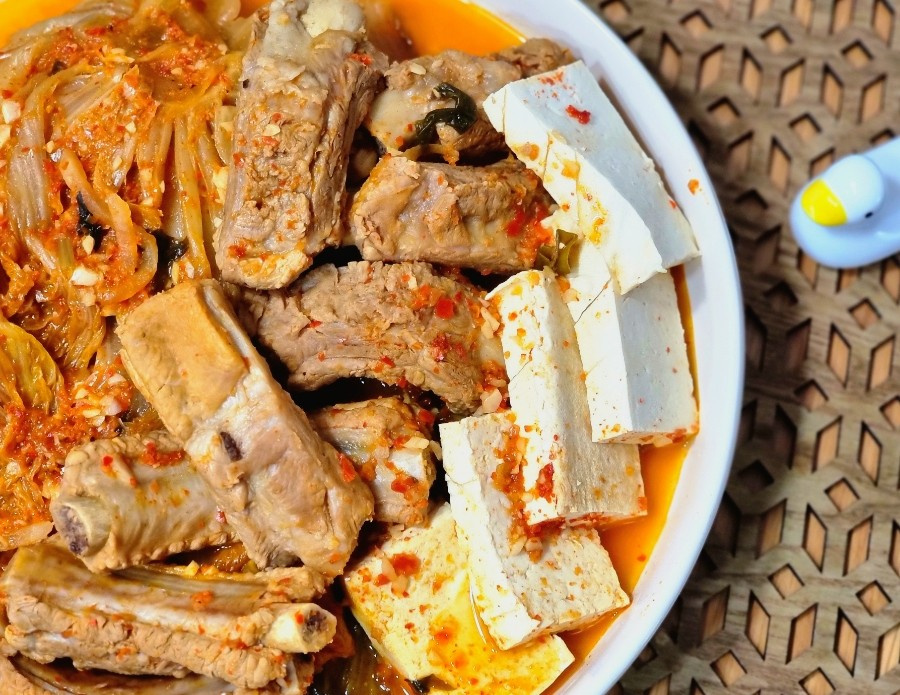Spicy & Tangy Pork Back Rib Kimchi Stew
How to Make a Deliciously Spicy Pork Back Rib Kimchi Stew

Learn how to make a deeply flavorful and zesty kimchi stew with pork back ribs, free from any gamey odors. While this recipe uses back ribs, feel free to substitute with pork belly, pork shoulder, or pork neck for a similar delicious result. It’s a hearty and satisfying meal that the whole family will love.
Main Ingredients- 1.2kg Pork back ribs
- 1 whole fermented napa cabbage (approx. 1kg)
- 700ml Anchovy and kelp broth
- 1 Onion
- 2 Green onions
- 4 Korean green chilies
Seasoning- 1 Tbsp Soy sauce
- 4 Tbsp Gochugaru (Korean chili flakes)
- 2 Tbsp Mirin (cooking wine)
- 1 Tbsp Soy sauce
- 4 Tbsp Gochugaru (Korean chili flakes)
- 2 Tbsp Mirin (cooking wine)
Cooking Instructions
Step 1
Begin by soaking the pork back ribs in cold water for about 30 minutes to remove any blood. This crucial step helps eliminate any unwanted gamey flavors, ensuring a clean and delicious stew.

Step 2
In a pot, add enough water to generously cover the back ribs. You can also add vegetable scraps like onion peels or green onion roots to help with odor removal. Once the water reaches a rolling boil, add the back ribs and a few peppercorns. Blanch for no more than 10 minutes. This process effectively removes impurities and any gamey smell from the ribs.

Step 3
After blanching, rinse the back ribs thoroughly under cold running water to wash away any remaining impurities. Drain them well and set aside. Rinsing after blanching contributes to a clearer and more refreshing broth.

Step 4
Prepare the broth that will add depth and umami to your kimchi stew. In a pot, combine 700ml of water with a broth pack (containing anchovies and kelp) and simmer for 10 minutes to create a rich, flavorful broth. This broth is key to elevating the overall taste of the stew.

Step 5
Prepare the vegetables that will enhance the stew’s flavor. Cut the onion into large chunks. Slice the green onions diagonally, and do the same for the Korean green chilies. Feel free to adjust the number of green chilies based on your preference for spiciness.

Step 6
Line the bottom of the stew pot with the prepared vegetables. This layer not only prevents the ribs and kimchi from sticking to the bottom but also infuses them with a subtle aroma as they cook. Arrange the blanched pork back ribs attractively on top of the vegetables.

Step 7
If you are using well-fermented kimchi (mukimchi), you might want to remove some of the radish filling. This helps to prevent the stew from becoming cloudy and results in a cleaner taste.

Step 8
Now, it’s time to add the fermented cabbage. Cut the whole cabbage in half and place it on top of the pork back ribs in the pot. As the cabbage cooks, it will soften and blend beautifully with the tender ribs.

Step 9
Mix the seasoning for the kimchi stew. In a separate bowl, combine 50ml of the prepared broth with 1 tablespoon of soy sauce, 4 tablespoons of gochugaru, 2 tablespoons of mirin, and a generous tablespoon of minced garlic. Whisk everything together. This seasoning mixture is the secret to achieving that deep, savory flavor in both the ribs and the kimchi.

Step 10
Pour the seasoning mixture and the remaining anchovy broth into the pot. Cover with a lid and bring to a boil over high heat. Once boiling, reduce the heat to medium-low and let it simmer until everything is tender. While a 30-minute simmer is acceptable if you’re short on time, cooking for at least an hour or longer will yield the most tender kimchi and melt-in-your-mouth ribs. The longer it simmers, the deeper the flavors become.

Step 11
Partway through the cooking, lift the lid and gently turn the cabbage over to ensure even cooking. Replace the lid and continue to simmer. If the broth seems too reduced, you can remove the lid for the last few minutes of cooking to slightly thicken it. If it’s not salty enough, add a little more soy sauce to adjust the seasoning to your liking.

Step 12
Your delicious pork back rib kimchi stew is ready! For an added touch, you can include some tofu towards the end. If adding tofu, place sliced tofu into the stew during the last 5 minutes of cooking. Serve hot with a side of rice and enjoy this hearty, flavorful meal!



